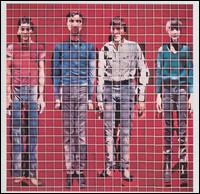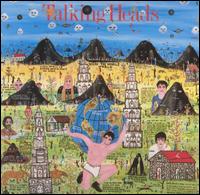There are those who mourn the vanishing of the nice big cardboard packages that vinyl came in. The format allowed fairly large images, credits, and photos. The usual assumption is that much of this imagery, like music videos, is a reflection of, and extension of, the music creator’s sensibility. As if the packaging and the videos were usually under the direct control of the author. This is absurd. Though pop artists attempted to wrestle control of the way they were presented from the distributors beginning in the 60s, most LPs design, and music videos as well, are directed and designed under the control of the record companies.It is ironic that Byrne would label this assumption as "absurd," given that his former band, which was composed of former RISD students, was the most famous of its era for its striking and imaginative album covers (and its music videos) which they either designed themselves or commissioned fine artists to do for them. Here are a few quick examples:
 The front cover of the album which was conceived and executed by David Byrne is a life-size photomosaic of the band made of 529 close-up Polaroid photographs.
The front cover of the album which was conceived and executed by David Byrne is a life-size photomosaic of the band made of 529 close-up Polaroid photographs.  The album cover and liner notes were created by the notable graphic designer, Tibor Kalman.
The album cover and liner notes were created by the notable graphic designer, Tibor Kalman. This one was designed by Byrne himself, but there was also a limited edition version designed by none other than Robert Rauschenberg.
This one was designed by Byrne himself, but there was also a limited edition version designed by none other than Robert Rauschenberg. The cover art was created by outsider artist Howard Finster, and was selected as album cover of the year by Rolling Stone magazine.
The cover art was created by outsider artist Howard Finster, and was selected as album cover of the year by Rolling Stone magazine.But I'm being unfair. I have no doubt that he's correct that "much" and "most" of this stuff was and is beyond the control of its creators. It is this passage that I found most interesting:
But downloads could offer so much more. They could be an opportunity to expand the experience rather than a whittling away of the music/image connection. For less than the price of printing those sleeves and CD booklets you could get slideshows, photos, videos, bios, credits, lyrics, merch…. some of this stuff could play on your MP3 player along with the music, the rest could be on your computer to view or print out. You could get way more than could ever fit on a dinky little CD booklet.Well, sure, maybe. But have you been to the movies lately? In the interminable time before the feature starts, what do you get? Not more art or even complementary packaging, but endless previews of other movies (i.e., commercials), and now, advertisements for products (i.e., more commercials). (Yes, DVDs do provide commentary tracks and "making of" featurettes, but they have previews and even commercials on them now too.) This is how empty space is filled in American culture. Not by providing art, education, enlightenment, or even "slideshows, photos, videos, bios, credits, lyrics, merch," but ads for more stuff you can buy. The same thing is happening with websites now. More and more of them have ads on the page or even click-through ads. No one gives space away for free.
Ah well, Byrne is an artist. It's his job to dream about what could be.

No comments:
Post a Comment